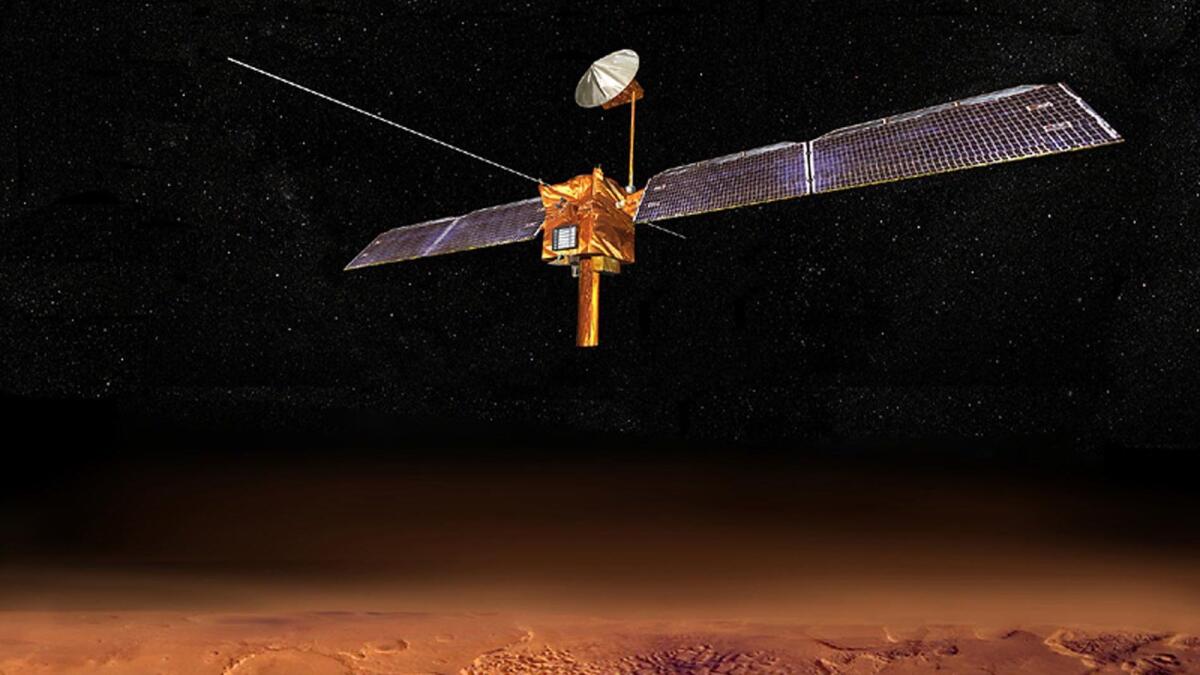Erosion is revealing surprising amounts of water ice on Mars

If future astronauts need to mine water on Mars, they may not even have to dig. Thanks to erosion wearing away the Martian surface, scientists using NASA’s Mars Reconnaissance Orbiter have spotted thick deposits of ice in the planet’s mid-latitudes that extend hundreds of feet deep.
The discovery, described in the journal Science, hints of snowfall on Mars in the recent geological past — and could offer researchers a tantalizing new spot to sample our dusty, rusty neighbor.
“This ice is a critical target for science and exploration: it affects modern geomorphology, is expected to preserve a record of climate history, influences the planet’s habitability, and may be a potential resource for future exploration,” the study authors wrote.
In spite of its dry appearance, about a third of the red planet actually holds shallow ground ice. But while that frozen water’s extent is fairly well known, other crucial details — how thick it is, what its layers look like, and how pure it is — largely remain unknown. If future explorers want to be able to draw down these water sources, scientists are going to have to learn much more about them.
The deposits described in this new paper offer a potential window into some of those mysteries.
“We’ve known for a while that Mars has ground ice that’s pretty widespread, and often pretty shallow,” said lead author Colin Dundas, a planetary geologist at the U.S. Geological Survey in Flagstaff, Ariz. “But what we’re able to see with these is that it’s layered in places and that there are these massive sheets of ice that reach very close to the surface.”
The researchers examined eight different exposed ice deposits on the planet spotted by the orbiter’s HiRISE camera. Seven of them are pole-facing scarps (that is, steep banks or slopes) in the Southern Hemisphere; one is a cluster of scarps in the Northern Hemisphere, in Milankovic Crater. They’re sharply defined and up to about 3.7 miles long.
“It was a bit of a surprise to see ice exposed at all,” Dundas said. “In the mid-latitudes, we know ice is present, but it’s usually centimeters to a meter or two beneath the surface, under dust and rocks and debris and so on.”
The scarps appear to have been exposed as the ice sublimated from a solid to vapor over time due to sun and wind exposure. Because the slopes are typically around 45 degrees, the orbiter’s instruments were able to get a look at the vertical layers, too.
These ice deposits could start just 1 to 2 meters beneath the surface but can extend more than 100 meters (or more than 328 feet) deep. They’re capped with a layer of rock and dust that’s been cemented with ice. These deposits seem to be pretty pure in terms of composition — not a lot of dust or dirt mixed in — which was not what scientists originally expected. Some of the slopes also show banded layers of icy material.
“Seeing this kind of detail can teach us a lot,” Dundas said.
On one of the scarps, a number of boulders have fallen out as the ice retreats. Those boulders actually allowed scientists to compare before-and-after images to calculate how fast the ice was shrinking back (a few millimeters every summer).
The researchers think the ice deposits started out as snow or frost that fell, was compacted and then recrystallized.
“It’s been hypothesized by others that snow could have fallen within the last several million years during periods when Mars’ axis was more tilted than it is now,” Dundas said.
The planet’s tilt is thought to have varied between 15 and 35 degrees within the last few million years, dramatically changing the climate when it shifted.
That’s not all that different from glaciers on Earth, which form from snow being compacted over time. Here, glaciers are a crucial tool for understanding our planet’s atmospheric history. Each layer of snow laid down over time records a different epoch — and the deeper the layers, the older the epoch.
On Mars, these exposed ice deposits are relatively young, geologically speaking — on the order of millions of years old, Dundas said. And since they probably represent patterns of past snowfall, they can reveal what the more recent Martian climate was like.
“We’ve learned a lot about the ancient history in other ways,” Dundas said of Mars research. “This is preserving a record of what conditions have been like in relatively recent times — which is still quite interesting. It’s a different aspect of Mars science.”
And because they’ve already been excavated by erosion, they’re much easier to access.
“These shallow depths make the ice sheets potentially accessible to future exploration,” the authors wrote.
The next steps, Dundas said, are to study these eight sites in depth — and perhaps look for similar scarps across the planet.
“I think it will be useful for us in the community to understand how those specific sites fit into the much broader picture of ice all over Mars — seeing how they differ and are similar,” Dundas said.
Follow @aminawrite on Twitter for more science news and “like” Los Angeles Times Science & Health on Facebook.
MORE IN SCIENCE
Elephants, lions and other wild animals are exquisitely sensitive to the effects of war
Mysterious series of fast radio bursts may have been twisted by extreme environment
Nature boosts your mental health, and you don’t even have to leave the city to reap the benefits
UPDATES:
3:10 p.m.: This story has been updated with additional information from lead author Colin Dundas.
This story was originally published at 11:55 a.m.






